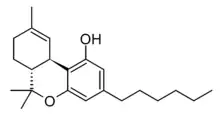Tetrahydrocannabihexol
 | |
| Identifiers | |
|---|---|
IUPAC name
| |
| CAS Number | |
| PubChem CID | |
| ChemSpider | |
| CompTox Dashboard (EPA) | |
| Chemical and physical data | |
| Formula | C22H32O2 |
| Molar mass | 328.496 g·mol−1 |
| 3D model (JSmol) | |
SMILES
| |
InChI
| |
Tetrahydrocannabihexol (Δ9-THCH, Δ9-Parahexyl, n-Hexyl-Δ9-THC) is a phytocannabinoid, the hexyl homologue of tetrahydrocannabinol (THC) which was first isolated from Cannabis plant material in 2020 along with the corresponding hexyl homologue of cannabidiol,[1][2] though it had been known for several decades prior to this as an isomer of the synthetic cannabinoid parahexyl.[3] Another isomer Δ8-THCH is also known as a synthetic cannabinoid under the code number JWH-124,[4][5] though it is unclear whether this occurs naturally in Cannabis, but likely is due to Delta-8-THC itself being a degraded form of Delta-9-THC. [6]
See also
References
- ↑ Linciano P, Citti C, Russo F, Tolomeo F, Laganà A, Capriotti AL, et al. (December 2020). "Identification of a new cannabidiol n-hexyl homolog in a medicinal cannabis variety with an antinociceptive activity in mice: cannabidihexol". Scientific Reports. 10 (1): 22019. Bibcode:2020NatSR..1022019L. doi:10.1038/s41598-020-79042-2. PMC 7744557. PMID 33328530.
- ↑ Radwan MM, Chandra S, Gul S, ElSohly MA (May 2021). "Cannabinoids, Phenolics, Terpenes and Alkaloids of Cannabis". Molecules. 26 (9): 2774. doi:10.3390/molecules26092774. PMC 8125862. PMID 34066753.
- ↑ Brown NK, Harvey DJ (1988). "Metabolism of n-hexyl-homologues of delta-8-tetrahydrocannabinol and delta-9-tetrahydrocannabinol in the mouse". European Journal of Drug Metabolism and Pharmacokinetics. 13 (3): 165–76. doi:10.1007/BF03189936. PMID 2853671. S2CID 10612593.
- ↑ Martin BR, Jefferson R, Winckler R, Wiley JL, Huffman JW, Crocker PJ, et al. (September 1999). "Manipulation of the tetrahydrocannabinol side chain delineates agonists, partial agonists, and antagonists". The Journal of Pharmacology and Experimental Therapeutics. 290 (3): 1065–79. PMID 10454479.
- ↑ Bow EW, Rimoldi JM (2016). "The Structure-Function Relationships of Classical Cannabinoids: CB1/CB2 Modulation". Perspectives in Medicinal Chemistry. 8: 17–39. doi:10.4137/PMC.S32171. PMC 4927043. PMID 27398024.
- ↑ Hazekamp, Arno; Fischedick, Justin T.; Díez, Mónica Llano; Lubbe, Andrea; Ruhaak, Renee L. (2010). "Chemistry of Cannabis". Comprehensive Natural Products II. pp. 1033–1084. doi:10.1016/B978-008045382-8.00091-5. ISBN 9780080453828.
This article is issued from Offline. The text is licensed under Creative Commons - Attribution - Sharealike. Additional terms may apply for the media files.

